Catherine Lalonde Memorial Scholarships

Call for Submissions: 2025 Catherine Lalonde Memorial Scholarships for Wood Related Research Catherine Lalonde Memorial Scholarships are presented to graduate students, enrolled at Canadian Universities, who demonstrate excellence in their studies of structural wood products or wood design. The Canadian Wood Council (CWC) invites submissions from graduate students in engineering, architecture, and wood science. Submitted projects must demonstrate their value and impact on Canadian-made structural wood products and/or their role in advancing domestic wood construction. The CWC will award two scholarships to graduate students whose outstanding wood research not only demonstrates academic excellence but also mirrors the unwavering passion for the wood industry exemplified by Catherine Lalonde, in whose honor the scholarships are named. Catherine, a professional engineer, was a passionate representative of our industry who relentlessly championed the use of wood in residential and commercial construction during her 10 years with the CWC. She served as president of the CWC from 2000 until 2003 when she tragically lost her battle with cancer. This award was established to commemorate Catherine’s memory and perpetuate the legacy of excellence and advocacy she bestowed upon the Canadian wood products industry throughout her influential tenure at the CWC. Scholarship Details and Application Process 1. Scholarship Value Two scholarships, valued at $3,000 each, will be awarded to outstanding graduate students. 2. Who can apply? Students enrolled in graduate programs in engineering, architecture, or wood science whose work contributes to the advancement of domestic wood products and construction. 3. Application Process Step Requirement Deadline Step 1 – Notification of Interest The Notification of Interest submission period has now closed. Eligible applicants have been notified of their preselection via email. If you were unable to submit your Notification of Interest before the deadline for reasons beyond your control and expect to complete the full application on time, please contact Ioana Lazea at ilazea@cwc.ca to discuss your situation. Closed – October 17, 2025 Step 2 – Full Application Submission Preselected applicants have been invited to complete the Full Application through a dedicated portal and upload all required documents (see checklist below). November 14, 2025 4. Full Application Submission Checklist For Step 2, applicants must upload the following documents to the submission portal: One cover letter. Official transcripts: Master’s applicants: undergraduate and graduate transcripts. Doctoral applicants: master’s transcript. Two-page description of the project, plus up to two pages of drawings or photos (if applicable). Two letters of reference, preferably from faculty members or supervisors familiar with the applicant’s work. For additional information, please contact Ioana Lazea at ilazea@cwc.ca
Acoustic Comparative Study
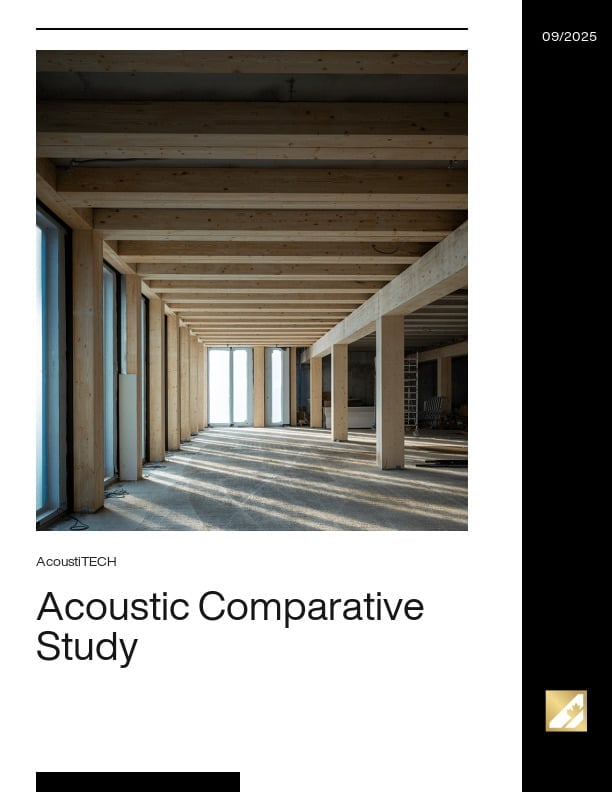
In a context where wood construction is gaining momentum, acoustics remains a key challenge in ensuring occupant comfort and compliance with standards. With this in mind, AcoustiTECH, an expert in acoustic solutions, has partnered with FPInnovations, a leader in research and development in the wood sector, to conduct an in-depth comparative study in its laboratory facility. Who We Are AcoustiTECH is a broker specializing in acoustic solutions, supporting building professionals in selecting highperformance materials that meet and exceed industry standards. With 25 years of experience and unique expertise, we offer customized assemblies through a specialized brand ecosystem and reliable data. Our personalized service, backed by dedicated technical and engineering teams, ensures tailored and effective solutions that enhance the acoustic comfort of occupants. FPInnovations is a globally recognized, private, non-profit organization specializing in research and development for the forestry sector. Its mission is to support businesses and building professionals in innovating and optimizing wood-based materials. With ISO 17025-accredited laboratories and state-of-the-art facilities, FPInnovations assesses the performance of wood structures in terms of acoustics, vibrations, fire resistance, and more. Study Objective At AcoustiTECH, our goal is to continuously innovate by delivering new data and acoustic solutions tailored to the specific requirements of each project. This collaboration with FPInnovations marks a significant milestone in our acoustic analysis of wood structures, as it represents our first large-scale data collection on a GLT masstimber slab and our second mass-timber campaign overall, building on a prior study. Through this study, we obtain precise acoustic measurements for this structural system and conduct rigorous comparisons across numerous innovative market solutions. We take into account key project criteria such as acoustic performance, budget, thickness, weight, and even design, as different acoustic solutions can also influence the choice of floor coverings. Grounded in a scientific approach and conducted in controlled environments with FPInnovations, this research aims to evaluate various acoustic configurations optimized for mass timber construction. By combining technical expertise, innovation, and in-depth analysis, we provide architects, engineers, and developers with high-performance solutions that meet and exceed the industry standards.
Wood Design & Building Award Winning Projects Announced
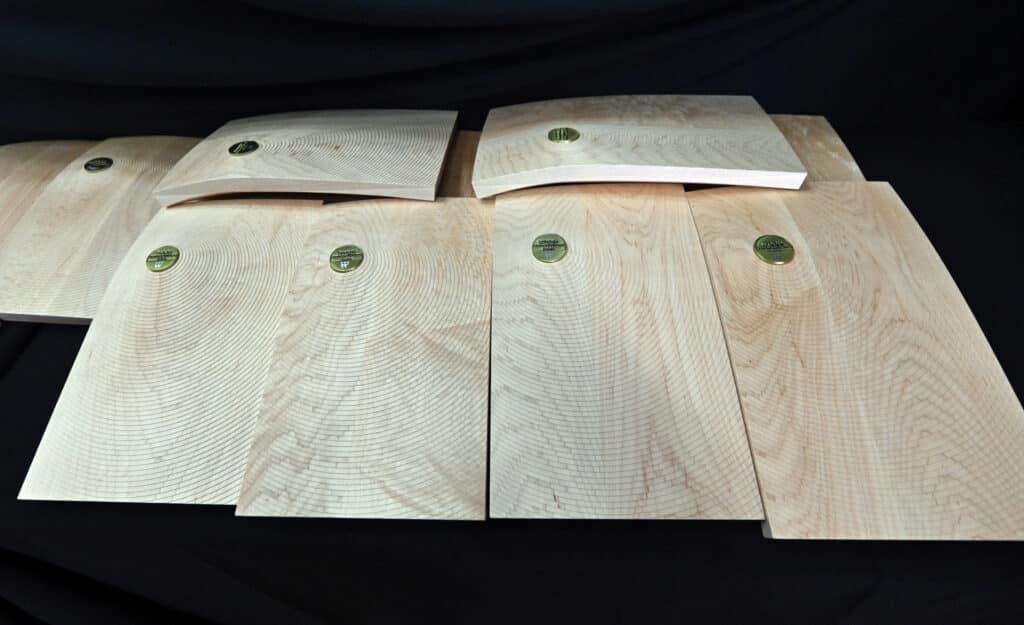
Vancouver, BC – September 23, 2025 – The Canadian Wood Council is pleased to announce the winning projects of the 41st annual Wood Design & Building Awards program. This prestigious awards program recognizes and celebrates the outstanding work of architectural professionals from Canada and around the world for excellence in wood design and construction. “The diversity and creativity in this year’s winning projects demonstrate how wood can connect people with nature,” says Martin Richard, Vice President of Communications and Market Development at the Canadian Wood Council (CWC). “These designs not only showcase wood’s versatility, but also create spaces that enrich daily life and support community well-being. They are high-performance solutions that respond to today’s urgent need for housing, schools, and community spaces.” “It’s a delight each year to see the latest and greatest wood buildings nominated to our awards program and it’s a privilege to recognize the best projects from the impressive submissions we receive,” added Ioana Lazea, Senior Project Manager at CWC responsible for delivering the awards program. “This year’s competition drew a remarkable 140 entries. We are deeply grateful to our esteemed jurors for the significant effort they invested in reviewing each one and for their careful deliberations in selecting the winners.” 18 projects earned recognition from the Wood Design & Building Awards jury. The jurors for the Wood Design & Building Awards were: Omar Ghandi, Principal at Omar Ghandi Architects Jane Abbott, Partner at Abbott Brown Architects Alec Holser, Founding Principal at Opsis Architecture 14 additional projects were selected for recognition under the WoodWorks category of the Wood Design Awards programs which have regional competitions in BC, Ontario, and the Prairie provinces for projects located in those jurisdictions. The jurors for the WoodWorks Awards category were: Eric Karsh, Founding Partner of Equilibrium Brenda Izen, Founding Principal at Izen Architecture Carol Belanger, City Architect, Edmonton In total, 38 projects from Canada and around the world were honoured at the Wood Design and Building Awards celebration hosted Tuesday, September 23, 2025, at the Woodrise Conference in Vancouver, BC. COMPLETE LIST OF AWARD-WINNING PROJECTS FOLLOWS: Honor The Spirit Garden (Toronto, ON) | Gow Hastings Architects in collaboration with Two Row Architects Fraser Mills Presentation Centre (Coquitlam, BC) | Patkau Architects Pacific Northwest Residence (Washington State) | Cutler Anderson Architects Google Borregas (Sunnyvale, CA, USA) | Project Designer: MGA | Michael Green Architecture, Architect of Record: SERA Architects TRUMPF Education Center (Ditzingen, Germany) | Barkow Leibinger Dwelling on the Mountainside: Jiuceng Art Gallery (Lishui, Zhejiang Province, China) | Atelier Lu+Architects Merit Vesterheim Commons (Decorah, IA, USA) | Snøhetta DogTrot Magnetawan (Magnetawan, ON) | Williamson Williamson Aiken Audubon Research Outpost (Chico Basin Ranch, CO, USA) | ColoradoBuildingWorkshop at CU Denver Citation Walking Dunes (Amagansett, NY, USA) | Bates Masi + Architects Timbrelyn (Bethel, NY 12720, USA) | Adel Research Group (ARG) sʔitwənx Child Care (Kelowna, BC) | Public Architecture + Design Canadian Canoe Museum (Peterborough, ON) | Unity Design Studio Greenhill School, Rosa O. Valdes STEM + Innovation Center (Addison, TX, USA) | Bohlin Cywinski Jackson Upper Canada College – Lindsay Boathouse (Toronto, ON) | VJAA Inc. (Lead Design Architect) | RDHA (Architect of Record) Winthrop Library (Winthrop, WA, USA) | Johnston Architects (Architect of Record) and Prentiss Balance Wickline Architects (Associate Architect) Toronto and Region Conservation Authority Headquarters (Toronto, ON) | Bucholz McEvoy Architects + ZAS Architects and Interiors MUMO (Museum of Motorcycle) (Puerto Octay, North Patagonia, Chile) | DRAA Sansin Sponsored Award Google Borregas (Sunnyvale, CA, USA) | Project Designer: MGA | Michael Green Architecture, Architect of Record: SERA Architects Sustainable Forestry Initiative Sponsored Awards Wahta’ elementary school (Wendake, QC) | DG3A Architecture Kreher Preserve & Nature Center Environmental Education Building (Auburn, AL, USA) | Leers Weinzapfel Associates Architects, Inc. Western Red Cedar Sponsored Awards San Juan Islands Residence (Eastsound, WA) | Vandervort Architects The Granary at Southlands (Delta (Tsawwassen) – BC) | MOTIV Architects Wood Preservation Sponsored Award Catchacoma Cottage (The Kawarthas, Municipality of Trent Lakes, ON) | Dubbeldam Architecture + Design WoodWorks Ontario Wood Design Awards DogTrot Magnetawan (Magnetawan, ON) | Williamson Williamson Ontario Secondary School Teachers’ Federation (OSSTF) Headquarters and Multi-Tenant Complex (Toronto, ON) | Moriyama Teshima Architects Toronto and Region Conservation Authority Headquarters (Toronto, ON) | Bucholz McEvoy Architects + ZAS Architects and Interiors Upper Canada College – Lindsay Boathouse (Toronto, ON) | VJAA Inc. (Lead Design Architect) | RDHA (Architect of Record) 1120 Ossington (Toronto, ON) | mcCallumSather WoodWorks BC Wood Design Awards Fraser Mills Presentation Centre (Coquitlam, BC) | Patkau Architects Adams Lake Health + Wellness Centre (Chase, BC) | Unison Architecture Ltd. Kin Park Pavilion and Ice Rink (Fort St. John, BC) | Public Architecture + Design sʔitwənx Child Care (Kelowna, BC) | Public Architecture + Design Point Grey House (Vancouver, BC) | Patkau Architects WoodWorks Prairie Wood Design Awards F Residence (RM of Stanley, MB) | 1×1 architecture inc. Riel Construction Office, (Dugald, MB) | Republic Architecture Inc. Sam Centre (Calgary, AB) | Diamond Schmitt Architects G7 Summit – Interior Renovations (Kananaskis, AB) | 1×1 architecture VIEW A VIDEO COMPILATION OF THIS YEAR’S WINNERS HERE: https://cwc.ca/WoodDesignandBuildingAwards2025/ FOR MORE INFORMATION, PLEASE CONTACT: Sarah Hicks Communications Manager, Canadian Wood Council 1-705-796-3381 | shicks@cwc.ca
Canadian Wood and Forestry Resources

National Provincial Canadian Wood Council WoodWorks Forest Products Association of Canada Certification Canada Mass timber road map Natural Sciences and Engineering Research Council of Canada Forest sector funding programs The Canadian Forest Service Canada Action – Forestry Industry in Canada FPInnovations Forest Enhancement Society of BC Province of British Columbia – Ministry of Forests British Columbia, Forestry Innovation Investment Mass Timber Demonstration Program in British Columbia Alberta Forest Products Association Ontario Forest Industries Association Ontario Wood Cecobois Conseil de l’industrie forestière du Québec Maritime Lumber Bureau Government Resources Invest in Canada – Services The State of Canada’s Forests Annual Report Canadian Forests – Federal Government Mass Timber Action Plan Trade Commissioner Service Forestry and wood products Funding and financing for international business Opportunities for Wood (PDF) Two Sides – Canadian forests are a renewable natural resource Canadian Council of Forest Ministers – Healthy forests. Healthy communities. naturally:wood – Mass Timber Demonstration Program The State of Canada’s Forests Annual Report 2023 (.pdf) The Conference Board of Canada – Use of Forest Resources COFI – Forest Facts
Innovative Strategies for Light-Frame Mid-Rise Buildings in High-Seismic Regions
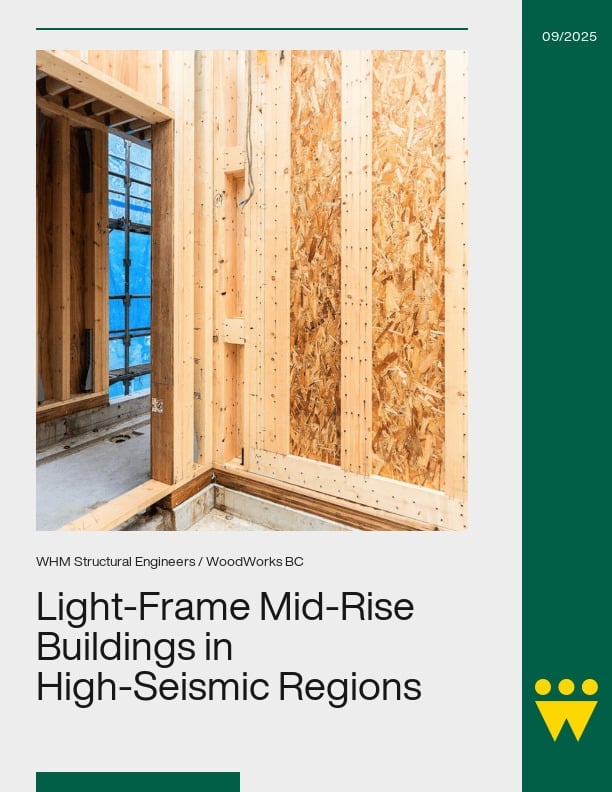
Innovative Strategies for Light-Frame Mid-Rise Buildings in High-Seismic Regions presents a detailed design example and practical guidance for engineers and builders responding to rising seismic demands on Canada’s West Coast. With the 2020 National Building Code of Canada significantly increasing seismic forces—particularly in Vancouver and Vancouver Island—conventional light-wood-frame (dimensional lumber) shearwall systems often no longer meet code requirements without costly additions. This guide, prepared by WHM Structural Engineers for WoodWorks BC and the Canadian Wood Council, explores two high-capacity shearwall solutions: Mid+Std walls, a code-compliant adaptation of Midply construction that achieves roughly 50% greater capacity than standard walls without increasing wall length, and Double Nail walls, a research-based approach using double rows of edge nails to match Mid+Std strength. Combined with lightweight floor topping strategies, these systems enable six-storey light-frame buildings to remain viable and cost-competitive even on poor soils and in the highest seismic regions. Cost analysis shows Mid+Std walls incur about a 30% framing cost increase over baseline, while Double Nail walls add about 20%, both more economical than doubling corridor wall lines. The publication includes complete design calculations, construction considerations, and conceptual connection details to help practitioners implement these strategies confidently. This resource equips designers, contractors, and owners with practical, innovative approaches to maintain the competitiveness of light-frame wood construction while meeting the stringent seismic requirements of the latest building codes.
Offsite Wood Construction Handbook
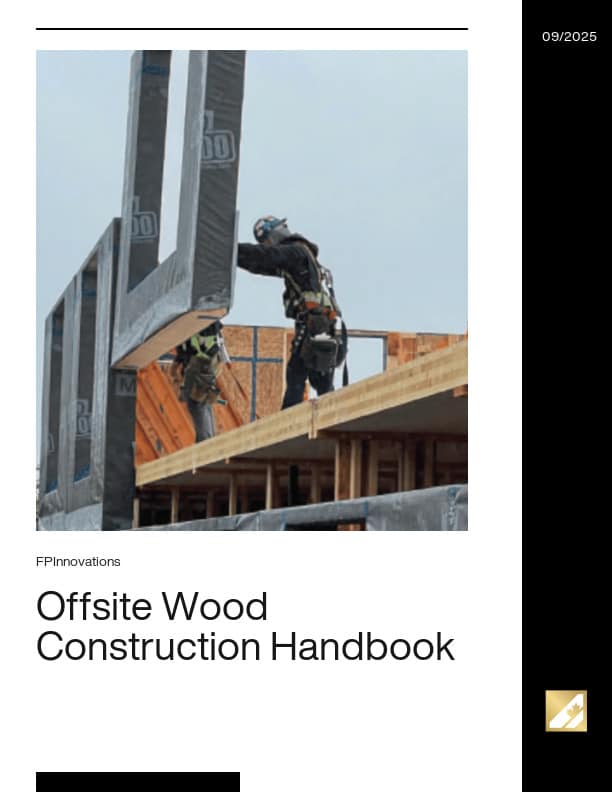
Industrialized offsite construction, also known as prefabricated or modular construction, is a construction method where building materials and components are manufactured and assembled offsite in factories before being transported to the project site for the final assembly. This approach can improve efficiency, reduce cost, and enhance quality compared to the traditional onsite construction. Industrialized offsite construction results from the reality of labour shortages, as well as the desire to automate manufacturing processes and shorten delivery schedules. As the construction industry evolves and processes are becoming automated, FPInnovations has been working on industrialized offsite construction for the last decade to ensure that the Canadian wood industry maintains its competitiveness. Guided by a comprehensive roadmap developed by FPInnovations and its partners in 2019 to identify the knowledge gaps, FPInnovations accelerated in the past five years to address the impacts of manufacturing and construction changes across the value chain. Inside the guide This in-depth guide on offsite wood construction includes chapters on the following topics: Design process associated with offsite construction Offsite manufacturing process Lumber and engineered wood product portfolio available in Canada for offsite construction Performance of buildings manufactured offsite Essential activities outside of manufacturing plants for offsite construction Environmental impacts of offsite construction
Canada’s Wood Industry Welcomes New Build Canada Homes Agency to Drive Rapidly Deployable Housing

September 15, 2025, Ottawa, ON: The Canadian Wood Council (CWC) welcomes the federal government’s launch of the Build Canada Homes (BCH) agency, announced yesterday by Prime Minister Mark Carney. Backed by a robust $13 billion investment and a plan to allocate federally owned lands for development, BCH will fast-track the delivery of affordable, sustainable housing nationwide. “This commitment to factory-built housing and prefabricated building components, including both mass timber and light wood frame systems, directly supports the architects, engineers, and builders we work with every day. It enables them to rapidly deploy quality homes at scale, while meeting Canada’s sustainability and affordability goals,” said Rick Jeffery, President and CEO of CWC. “We’re especially encouraged by BCH’s plan to adopt a ‘Buy Canadian’ policy and streamline permitting for bulk projects.” BCH’s first projects will be launched in Dartmouth, Longueuil, Ottawa, Toronto, Winnipeg, and Edmonton, with construction expected to begin next year. The agency will also work with the Nunavut Housing Corporation to deliver 700 homes, 30% of which will be built off-site and transported to Nunavut. In advance of this announcement, the Canadian Wood Council (CWC) with Forest Products Association of Canada (FPAC) submitted recommendations to the BCH Market Sounding Guide highlighting how wood-based modern methods of construction (MMC)—including mass timber, light wood frame, and modular systems—can reduce build times by up to 50%, cut carbon emissions by 30–60%, and lower long-term operating costs. The CWC and FPAC urges BCH to implement key recommendations from its submission, including: Loan guarantees and concessional financing for factory expansion. A national “one-window” approval system for factory-built housing. A Design for Manufacturing & Assembly (DfMA) pattern library. Indigenous equity and workforce development tied to housing pipelines. The CWC stands ready to champion this effort and ensure design and construction professionals have the information and support they need to rapidly deploy the sustainable, affordable homes Canadians need. –30– The Canadian Wood Council (CWC) is a leading force in advancing building codes and standards for wood construction, ensuring market access for Canadian wood products, and accelerating the adoption of sustainable, wood-based construction solutions in the marketplace. As a national federation of associations, the CWC serves as the unifying voice for our members, who represent hundreds of manufacturers across the country.
Canadian Wood Council’s WoodWorks Program Welcomes BarrierTEK as National Partner
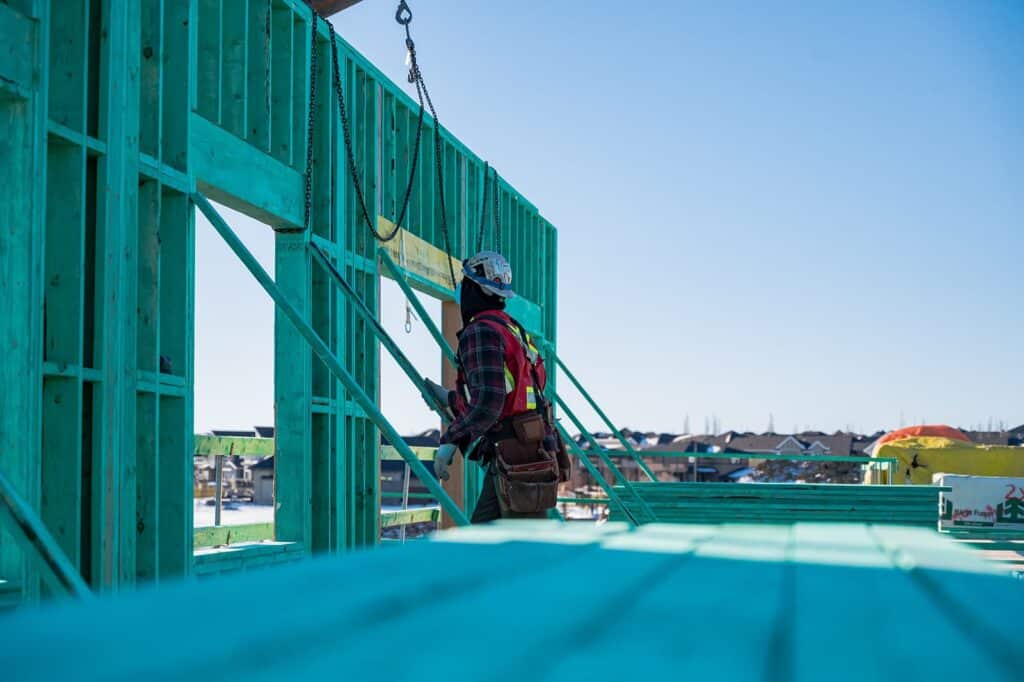
Ottawa, Ontario – September 9, 2025 — The Canadian Wood Council (CWC) is pleased to welcome BarrierTEK as a new national partner of its WoodWorks program. This collaboration aligns two organizations committed to supporting safe, innovative, and low-carbon construction practices across Canada through education, technical excellence, and strategic market development. As the construction sector responds to climate imperatives, shifting societal expectations, and progressive building codes, the role of wood in the built environment continues to expand. By combining traditional wood systems with value-added solutions like fire-retardant treatments, project teams can expand the application of wood in diverse building types without compromising performance or design flexibility. This partnership will help raise awareness of the full range of tools and technologies available to support safe, code-compliant wood construction while reinforcing wood’s reputation as a versatile, safe, high-performance building material. “WoodWorks is proud to collaborate with BarrierTEK to help build industry knowledge and confidence in the proven fire performance of wood construction,” says Martin Richard, Vice President of Market Development and Communications at the Canadian Wood Council. “This partnership supports our broader goal of advancing wood use in all forms by equipping professionals with practical, performance-based solutions.” “At BarrierTEK, our mission has always been to make fire safety more accessible without compromising the sustainability or affordability of wood construction,” says Ewan Davie, VP Sales at BarrierTEK. “Working alongside WoodWorks allows us to contribute to the national conversation on wood construction and demonstrate how innovation in fireperformance can enhance—not limit—wood’s role in shaping modern construction practices.” Through shared outreach, resource development, and technical education across the country, this national partnership aims to equip architects, builders, and developers with the knowledge they need to confidently design and build with wood. About the Canadian Wood Council The Canadian Wood Council (CWC) is Canada’s unifying voice for the wood products industry. As a national federation of associations, our members represent hundreds of manufacturers across the country. Our mission is to support our members by accelerating market demand for wood products and championing responsible leadership through excellence in codes, standards, and regulations. We also deliver technical support and knowledge transfer for the construction sector through our market leading WoodWorks program. About the National WoodWorks Program The Canadian Wood Council’s WoodWorks Program a national outreach initiative dedicated to advancing the use of wood in construction by providing educational opportunities and direct technical support. The program helps architects, engineers, developers and other industry professionals expand their capacity for wood design and construction, contributing to a more sustainable built environment. About BarrierTEK BarrierTEK is a Canadian company based near Edmonton, Alberta, at the forefront of enhanced fire performance of wood construction since 2010. Their team of chemists, engineers, and researchers collaborates with builders, code officials, and fire prevention authorities to develop cost-effective, non-toxic, factory-applied fire-retardant treatments for dimensional lumber, I-joists, OSB/plywood panels, attic trusses, and sheathing. These solutions meet or exceed Canadian and NFPA fire safety standards—while being LEED‑compliant and compatible with conventional construction processes—and are designed to reduce the risk and severity of high‑intensity fires in both single‑family and multi‑family wood buildings, delivering measurable benefits like lower insurance premiums and enhanced community safety.
Mass Timber Demonstration Fire Tests Program
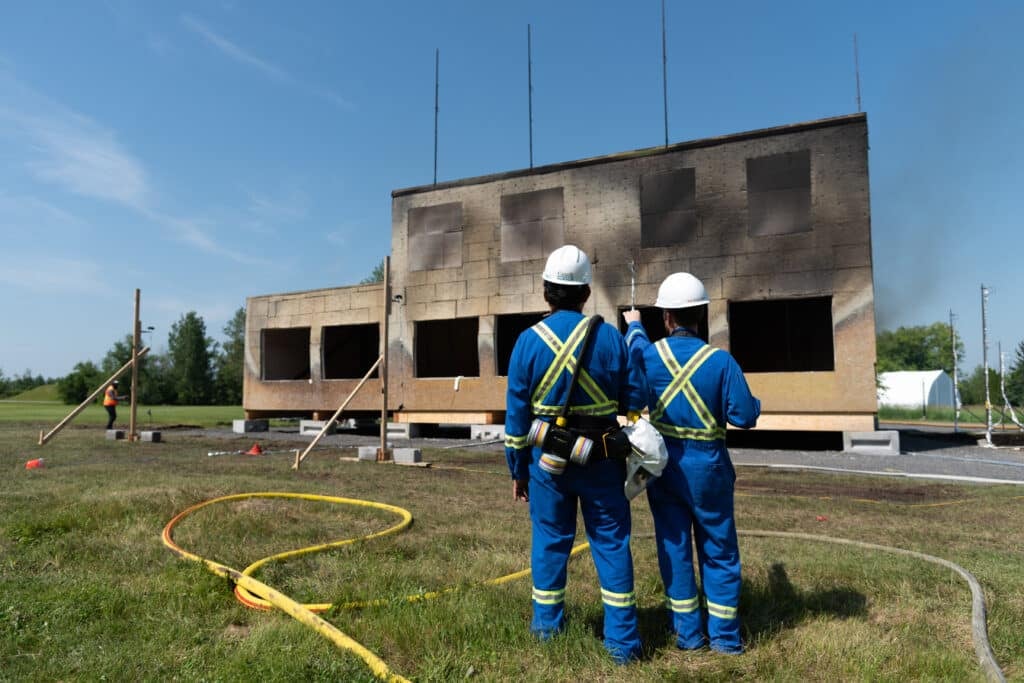
The Canadian Wood Council partnered with federal and provincial governments and organizations, as well as key experts, to conduct a series of five fire research burns on a full-scale mass timber structure in Ottawa. The five tests occurred in June 2022. The project supports market acceptance of tall and large mass timber buildings in Canada and encourages the construction of buildings that include mass timber. With the most certified sustainable forests in the world, Canada is a champion of sustainable forest management and in a position to solidify our global leadership in the bioeconomy and forest sector by advancing mass timber adoption. Mass timber is revolutionizing the building industry as a renewable, nature-based construction material. Recognizing mass timber’s vital role in achieving a low carbon, built environment, the Canadian Wood Council and its partners are dedicated to advancing its adoption. Click here for the final report Purpose The project was designed to support market acceptance of tall and large mass timber buildings in Canada and encourage the construction of buildings that include mass timber. By designing and executing a series of demonstration fire research tests on a full-scale mass timber structure, and collecting data from tests, the project: Demonstrated mass timber fire performance to key stakeholders including building officials, fire service and insurance industry Encouraged building code advancements that will allow for taller and larger wood buildings Support the adoption of the 2020 National Building Code introducing new provisions to allow 12 storey mass timber buildings Supported future code change proposals and the development of alternative solutions Encouraged the development of / provide data and information to support the transition toward performance-based codes, long-term strategy Promoted the adoption of mass timber by developing educational materials for targeted audiences Supported the maximum use of exposed mass timber elements (visual aesthetic), leading to cost competitive projects and health and wellness benefits Demonstrated the ability of different mass timber assemblies to maintain structural integrity under, during and post-construction fire scenarios in a way that is comparable to (or superior to) conventional materials. Supported the transition to Performance-based codes Summary of the Mass Timber Demonstration Fire Test #5 Objectives While there is evidence, research, and case studies that demonstrate the comparable, safety and performance of mass timber construction compared to construction using conventional materials like steel and concrete, misconceptions still circulate. By designing and executing a series of demonstration fire research burns on a full-scale mass timber structure, and collecting data from these burns, our objective was to: Showcase, through fire demonstration tests, that mass timber construction is a safe and viable alternative to other more conventional construction systems (steel & concrete) for constructing large or tall buildings; Support the implementation and adoption of the 2020 edition of the National Building Code of Canada; Support future code change proposals to extend the use of mass timber to other building types, heights, and sizes; Support the transition to Performance-based codes; Use the results and finds from the demonstration tests to develop viable solutions to mitigate construction fire risk. Targeted Audiences Various key stakeholders within the construction sector need to be educated through science-based tests that mass timber building systems can be designed to provide a safe building environment when subjected to fire. The key groups targeted by the project include, but are not limited to: Building Code Officials & Regulators Fire Services Professionals Insurance Professionals Building & Construction Industry Sustainability Specialists Building Occupants & Owners Funders & Stakeholders Natural Resources Canada BC Forestry Innovation Investment Government of British Columbia – Office of Mass Timber Implementation (OMTI) Ontario – Ministry of Northern Development, Mines, Natural Resources and Forestry Alberta – Agriculture, Forestry & Rural Economic Development Québec – Ministère des Forêts, de la Faune et des Parcs Canadian Wood Council FPInnovations Full Scale Fire Testing and Research The National Research Council of Canada (NRC) provided support for the technical work and science-based fire tests, as part of its research to inform the advancement of safe and innovative solutions across Canada’s construction industry. Key Consultants & Contractors GHL Consultants Ltd. CHM Fire Consultants Ltd. ISL Engineering Timmerman Timberworks Inc. Key Suppliers & Manufacturers Five mass timber product manufacturers supplied the mass timber materials: Western Archrib: ◦ Glulam beams and columns ◦ Westdek panels for the roof Element5 Modern Timber Buildings ◦ Glulam beams and columns ◦ CLT floor Structurlam Mass Timber Corporation ◦ Glulam beams and columns ◦ CLT floor and walls StructureCraft: Timber engineering & Construction: ◦ DLT floor and roof Nordic Structures ◦ Glulam beams and columns ◦ CLT roof and walls Several key material suppliers also supported the program: MTC ◦ Connectors and fasteners Rockwool ◦ Fire Proof Insulation Hilti ◦ Fireproof material The structure for the Ottawa Fire Test was built by Timmerman Timberworks Inc.
Canadian Wood Council and Canadian Institute of Steel Construction Partner to Advance Steel-Timber Hybrid Construction
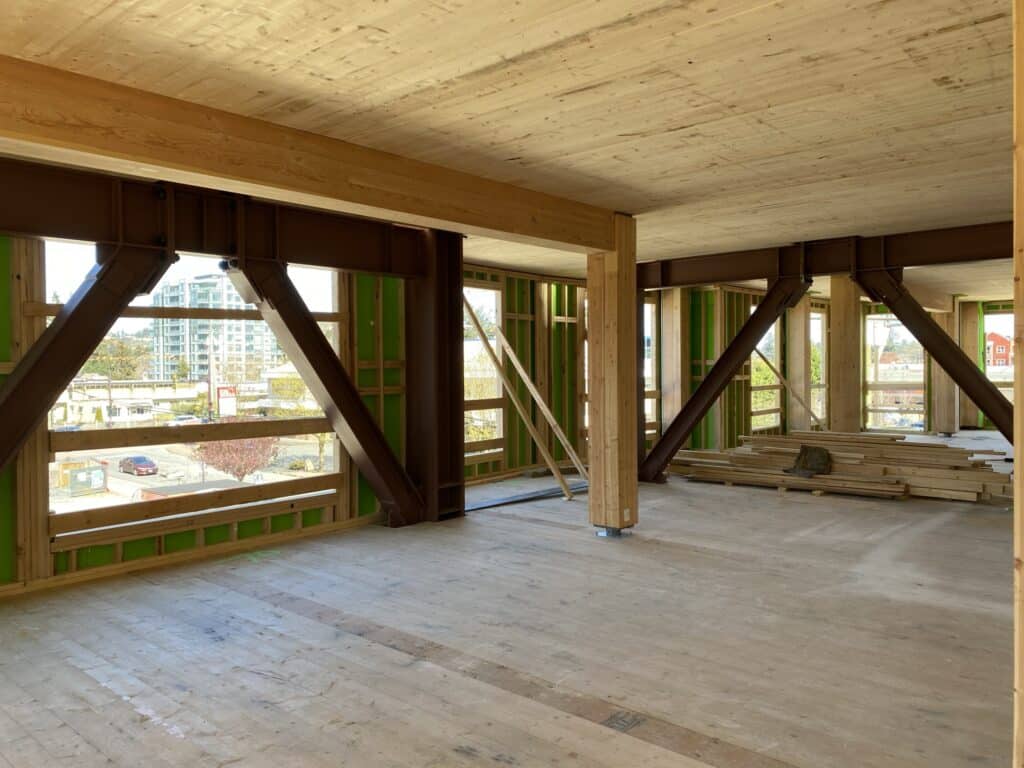
Ottawa, ON — September 4, 2025 — The Canadian Wood Council (CWC) and the Canadian Institute of Steel Construction (CISC) are pleased to announce a strategic partnership to accelerate the adoption of steel-timber hybrid structural solutions in Canada. Steel-timber hybrid construction is emerging as a sustainable and efficient approach to modern building design. By combining the strength and durability of steel with the renewable, low-carbon benefits of wood, hybrid systems—such as steel-timber composite floors—can deliver superior structural performance, improved cost efficiency, and faster construction timelines. These benefits are particularly valuable for larger and taller buildings where structural demands are greatest. To advance this opportunity, CWC and CISC have established a joint Technical Steering Committee. This committee will oversee the strategic use of funds contributed by both organizations to maximize industry impact. Its primary mandate is to support designers, engineers, and builders by developing technical guidance, best practices, and publications that will enable practical, code-compliant solutions for hybrid systems. “By working together, we aim to provide the industry with the resources it needs to deliver innovative, cost-effective, and sustainable building solutions,” said Robert Jonkman, Vice-President, Engineering, Canadian Wood Council. “This partnership reflects our shared commitment to advancing construction practices that meet today’s affordability and performance challenges,” added Logan Callele, Director of Engineering, Canadian Institute of Steel Construction. Further details on upcoming resources, publications, and industry engagement opportunities will be shared in the coming months. For more information, visit: www.cwc.ca For media inquiries, please contact: Martin Richard, VP, Communications and Market Development Canadian Wood Council mrichard@cwc.ca | 1-613-725-4339 About the Canadian Wood Council (CWC) The Canadian Wood Council is the national association representing manufacturers of Canadian wood products used in construction. Through technical expertise, market development, and education, CWC promotes the responsible use of wood, advancing building practices that are innovative, sustainable, and aligned with Canada’s climate goals. About the Canadian Institute of Steel Construction (CISC) The Canadian Institute of Steel Construction is the national industry organization representing the structural steel, open web steel joist, and steel plate fabrication industries. CISC works to advance the use of steel in construction through advocacy, education, research, and the development of design and construction resources.
Winnipeg Engineering Workshop – Simpson Strong-Tie
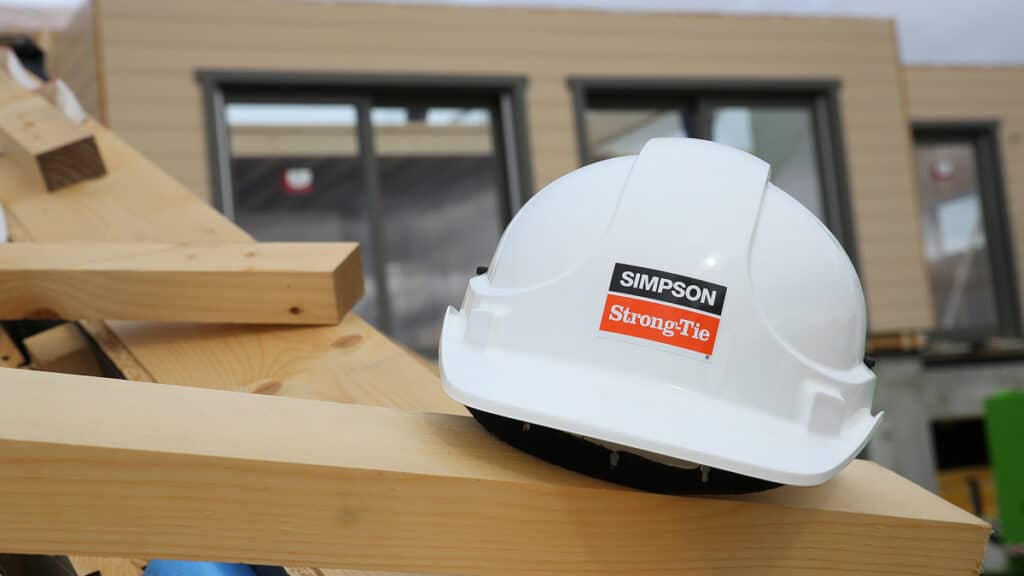
Canadian Wood Council Welcomes Federal Investment in Forestry Innovation and Housing Solutions
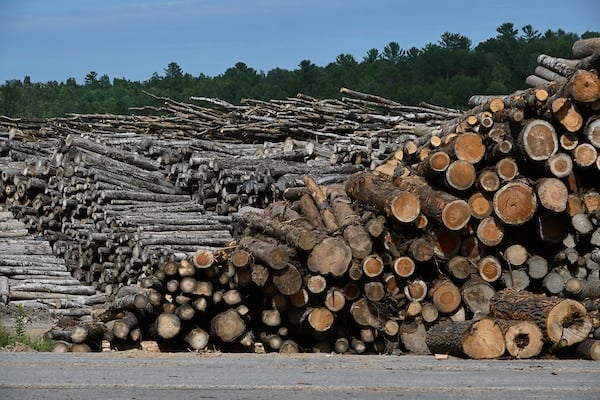
August 5, 2025 – (Ottawa, ON) The Canadian Wood Council (CWC) welcomes today’s announcement by Prime Minister Mark Carney in Kelowna, unveiling a $1.2 billion investment to support Canada’s forest sector and accelerate the use of Canadian wood in domestic construction. The measures – including $700 million in loan guarantees and $500 million to advance innovation, workforce development, and market diversification – send a strong signal of support for sustainable construction and domestic manufacturing. CWC is encouraged to see federal action aligned with the priorities it has long championed through its technical work in codes and standards and resource program delivery. “This announcement reinforces the critical role that wood-based solutions can play in meeting Canada’s housing and climate goals,” said Rick Jeffery, President and CEO of the Canadian Wood Council. “The focus on innovation, capacity expansion, and domestic use of wood aligns well with technical insights we’ve shared over many years through our work with government, industry, and the architects, engineers, construction professionals, and developers (AECD) community.” CWC has worked closely with federal departments and agencies, including Natural Resources Canada, on initiatives such as the Green Construction through Wood (GCWood) program, which has demonstrated the ability to de-risk early projects and help scale up Modern Methods of Construction (MMC). These approaches, such as mass timber and prefabrication, are essential to accelerating housing starts while reducing carbon emissions and supporting rural economies across Canada. “With the Build Canada Homes plan targeting 500,000 new units annually, today’s announcement provides important tools to help scale construction innovation,” Jeffery added. “Ensuring that Canadian wood products are part of the solution is a smart investment in housing, climate action, and economic resilience.” CWC will continue its work providing technical assistance, education, and data-driven insight to support the successful implementation of federal initiatives. The organization remains committed to working with all levels of government and industry partners to help increase the use of sustainable wood systems in construction.

